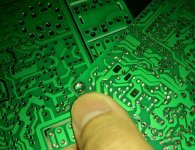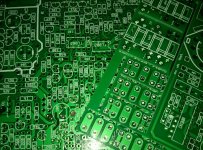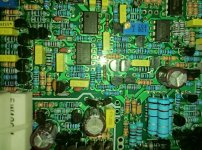I'd second all that. I've tried them both and they were quite nice, in the sense I could get them working quickly and I felt they could probably do the job. Eagle, I had the misfortune to try recently, when a potential client insisted I try it. As a Protel/Altium user, I found it to be impossibly obscure and had to abandon the job. I'm sure Eagle users might say the same of Protel or Altium with its weird design management systems, but for me it wasn't worth the struggle. I was surprised how difficult it was.
Eagle, I had the misfortune to try recently, when a potential client insisted I try it. As a Protel/Altium user, I found it to be impossibly obscure and had to abandon the job. I'm sure Eagle users might say the same of Protel or Altium with its weird design management systems, but for me it wasn't worth the struggle. I was surprised how difficult it was.
Its always difficult going from one CAD package to another.
I sell PCBCAD51 and occasionally get comments like "It doesn't work like CAD package x" Well it shouldn't or I might get sued for plagurism.
Its always difficult going from one CAD package to another.
I sell PCBCAD51 and occasionally get comments like "It doesn't work like CAD package x" Well it shouldn't or I might get sued for plagurism.
You are quite right. If one package is too similar to another, there would be a copyright issues! Unfortunately, CAD work involves a lot of actions and in the course of which we memorise so many things like hot keys and the like. Which is why it is so difficult to migrate. For instance, I had been using the DOS program Easytrax for years because it had become like second nature to me. I could use it even in linux with DOSBOX and used a flatbed plotter to fabricate my protopypes. That is, until I encountered SMD footprints like TSSOP and the like which it could not handle. The only linux option seemed to be geDA which, with all its 'open source' related limitations, is now working for me.
The bottom line is, this type of discussion is bound to continue...
for simple pcb, there is a powerful pcb demo version from cadint.
at 1st run, it may difficult and less user friendly, but it will be the quickest and fully cuztomizable one when you experienced well with it.
if your pcb ready, simply make gerber files and examine with gerbv (geda), then let chinese manufacture it for unreasonable cheap price. $9.8 for 12pcs 10x10cm board. they did the pcb very nice. they says 6mills but I did some place with 4mill and still flawlessly good.
at 1st run, it may difficult and less user friendly, but it will be the quickest and fully cuztomizable one when you experienced well with it.
if your pcb ready, simply make gerber files and examine with gerbv (geda), then let chinese manufacture it for unreasonable cheap price. $9.8 for 12pcs 10x10cm board. they did the pcb very nice. they says 6mills but I did some place with 4mill and still flawlessly good.
Agree, with the other posting above, I do think the wisest thing to do is to stick with a currently existing one, making sure you are always up to date with the industry standard.. There now exist's free CADware version from known labels, Altium had Circuitmaker, Cadence had OrCAD Lite, National Instruments had Multisim Blue.from Mouser. Designsoft had TINA-TI from Texas Instruments (not sure though if this one offers PCB design).
Other free version for non-profit use, Diptrace, ZenithPCB, Target 3001, AutoTrax DEX (v9.0 only) also one popular open source project is KiCAD.
Depending on your demands and personal preference, i.e. for hobby use only, schematic capture function, number of components in the library, small installation package, wide working area (panel view) GUI feel, does not take up much pc power, non intrusive (some will halt your progress if you skip a few steps) etc.
Pick one and stick with it in order to develop a masterful skill. IMHO PCB designing is about the artist.
Other free version for non-profit use, Diptrace, ZenithPCB, Target 3001, AutoTrax DEX (v9.0 only) also one popular open source project is KiCAD.
Depending on your demands and personal preference, i.e. for hobby use only, schematic capture function, number of components in the library, small installation package, wide working area (panel view) GUI feel, does not take up much pc power, non intrusive (some will halt your progress if you skip a few steps) etc.
Pick one and stick with it in order to develop a masterful skill. IMHO PCB designing is about the artist.
I see that cadint also become slightly expensive today. if they sell old version for cheap it may really worth for diy ppl.
kicad seems promising, its open source, and may get more support later. it does't need much money for decent pcb today.
most important is choose one that support gerber files. because if your pcb is 10x10cm chinese manufacturer is worth to try for cheap. you don't need to print it and drill it yourself.
I recomend elecrow or pcbway they have decent manufacturing procedure and customer service.
here. an example from elecrow pcb. very good for this price, saving both my time and fund.
kicad seems promising, its open source, and may get more support later. it does't need much money for decent pcb today.
most important is choose one that support gerber files. because if your pcb is 10x10cm chinese manufacturer is worth to try for cheap. you don't need to print it and drill it yourself.
I recomend elecrow or pcbway they have decent manufacturing procedure and customer service.
here. an example from elecrow pcb. very good for this price, saving both my time and fund.
Attachments
I see that cadint also become slightly expensive today. if they sell old version for cheap it may really worth for diy ppl.
kicad seems promising, its open source, and may get more support later. it does't need much money for decent pcb today.
most important is choose one that support gerber files. because if your pcb is 10x10cm chinese manufacturer is worth to try for cheap. you don't need to print it and drill it yourself.
I recomend elecrow or pcbway they have decent manufacturing procedure and customer service.
here. an example from elecrow pcb. very good for this price, saving both my time and fund.
Interesting way to annotate resistors with their value.
I guess it makes populating the pcb easier.
However, if you have to debug the pcb then which is R1 ?
Maybe a combination of R1 and value together (if there is room) might be better? R1-47K
in the past it was more text with smaller font and just square simbols for resistor, ic, etc, but later I found its more pleasant on my eyes while placing component with bigger text only simple value on it. and better symbols not just square and circle. just try it, its very pleasant at placement work.
Laying out PCBs is easy in ExpressPCB,even for the first time user. And TinyCAD helps you draw circuit diagrams.
Laying out pcb's for a beginner can be an absolute nightmare where high and low currents flow together. Look up star grounding.
I designed an audio mixer and just laid out the tracks as they came.
Powered it up and got 1VRMS AC on the output with inputs shorted !
When I looked into it I had mixed in the smoothing capacitor ground line with the audio ground line and the audio ground was being modulated by smoothing capacitor charging impulses.
I reworked the pcb keeping power supply totally separate and it worked very well.
I'm looking for some good PCB design software.
What are people using?
What's the best/cheapest/most popular out there?
tia-
WAH
PAD2PAD no limit
PAD2PAD no limit
PCBCAD51 no limits.
PCBCAD360 no limits.
Both on ebay.
make sure that any 'free' PCB software you get allows you to export GERBER files so PCBs can be ordered from ANY vendor - otherwise you may find yourself stuck with one PCB fab house you can use with your design!
I've done pretty well with PCBWEB (PCBWeb), which is connected to board houses but also allow you to generate standard Gerbers that you can send to any house you like. They haven't added anything (not even blogs) to their web site since last year, though, which is a bit concerning.....
I've done pretty well with PCBWEB (PCBWeb), which is connected to board houses but also allow you to generate standard Gerbers that you can send to any house you like. They haven't added anything (not even blogs) to their web site since last year, though, which is a bit concerning.....
make sure that any 'free' PCB software you get allows you to export GERBER files..
I have found thorough design rules checking in the software is vital.
Things like single ended nets, layers out of range, clearance checking, min via size checking etc etc
One bad pcb batch back and they can all end up in the bin.
DOS OrCAD 386+ still rules here
Back in the early 1990's, I purchased OrCAD: SDT386+ for schematic capture, and PCB386+ for layout, and paid annual maintenance/upgrade/support for several years.
I have never yet seen anything that makes me want to get something "more modern". 16 copper layers, plus 12 layers for silkscreen, adhesive, solderpaste, assembly, soldermask, comment, ECO, etc... max board size is 32"x 32". Excellent DRC checking, except for false DRC violations around arcs. Outputs Gerber, Excellon, PostScript, DXF, HPGL/2, and more, just about any format I've ever needed. Flexible BOM generation. Unlimited component count other than by sheet size or RAM...
I currently run it under DOSBox in Linux up to 1024x768 screen, and Windows GDI video drivers are available to run at any native Windows screen resolution.
I've done that up to 1920x1200, anything more is just silly.
The cool thing is, the software is effectively public domain, now. There's a user/support group on Yahoo Groups:
Yahoo! Groups
... which has a huge file section (install packages, manuals, libraries, drivers etc.), and answers to every question that's ever been asked. The founder of OrCAD, and original software author, John Durbetaki, is a member there, and still answers questions. If anyone wants a zip of a configured installation, pm me. This is not considered piracy by either Mr. Durbetaki nor the current owners of the OrCAD brand, neither has intere$t in such an old version.
But, Mr. Durbetaki "got it right the first time". Everything since is fashion, and data integration.
I started doing PCB layouts in the late 1970's, using Bishop Graphics Stik-Ons and red and blue tape on mylar, photo-separations and reductions, pin-registered overlays, creative use of size-as negs to make voltage plane and soldermask layers. Final schematics were hand-drawn with rapidograph pen on matte mylar. OrCAD was an epiphany for me, nothing yet has tempted me to change (and yes, I've test-driven KiCad, Eagle, PADs, and a bunch of others). YMMV.
Ya ok, time. Cheers.
time. Cheers.
-Peter
Back in the early 1990's, I purchased OrCAD: SDT386+ for schematic capture, and PCB386+ for layout, and paid annual maintenance/upgrade/support for several years.
I have never yet seen anything that makes me want to get something "more modern". 16 copper layers, plus 12 layers for silkscreen, adhesive, solderpaste, assembly, soldermask, comment, ECO, etc... max board size is 32"x 32". Excellent DRC checking, except for false DRC violations around arcs. Outputs Gerber, Excellon, PostScript, DXF, HPGL/2, and more, just about any format I've ever needed. Flexible BOM generation. Unlimited component count other than by sheet size or RAM...
I currently run it under DOSBox in Linux up to 1024x768 screen, and Windows GDI video drivers are available to run at any native Windows screen resolution.
I've done that up to 1920x1200, anything more is just silly.
The cool thing is, the software is effectively public domain, now. There's a user/support group on Yahoo Groups:
Yahoo! Groups
... which has a huge file section (install packages, manuals, libraries, drivers etc.), and answers to every question that's ever been asked. The founder of OrCAD, and original software author, John Durbetaki, is a member there, and still answers questions. If anyone wants a zip of a configured installation, pm me. This is not considered piracy by either Mr. Durbetaki nor the current owners of the OrCAD brand, neither has intere$t in such an old version.
But, Mr. Durbetaki "got it right the first time". Everything since is fashion, and data integration.
I started doing PCB layouts in the late 1970's, using Bishop Graphics Stik-Ons and red and blue tape on mylar, photo-separations and reductions, pin-registered overlays, creative use of size-as negs to make voltage plane and soldermask layers. Final schematics were hand-drawn with rapidograph pen on matte mylar. OrCAD was an epiphany for me, nothing yet has tempted me to change (and yes, I've test-driven KiCad, Eagle, PADs, and a bunch of others). YMMV.
Ya ok,
 time. Cheers.
time. Cheers.-Peter
Last edited:
Its always easiest to stick with what you know.
I find people who have come from another CAD package to mine are always the worst for complaints.
They ask why mine doesn't work the same as package X ?
Why are the key presses different ?
I still have a DOS CAD package from 1990.
Runs fine under DOS box in Win 10.
I find people who have come from another CAD package to mine are always the worst for complaints.
They ask why mine doesn't work the same as package X ?
Why are the key presses different ?
I still have a DOS CAD package from 1990.
Runs fine under DOS box in Win 10.
- Status
- This old topic is closed. If you want to reopen this topic, contact a moderator using the "Report Post" button.
- Home
- Design & Build
- Software Tools
- PCB Design Software


